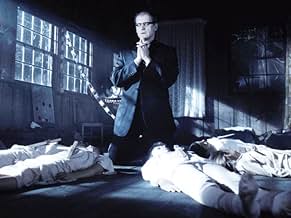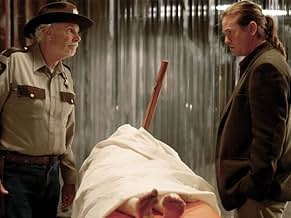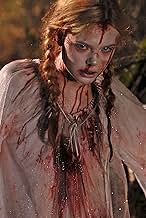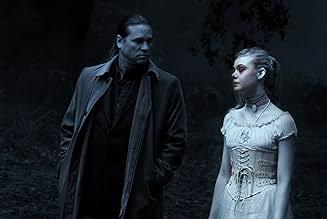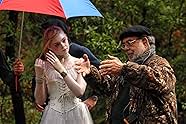Un escritor de terror en apuros llega a un pequeño pueblo en una gira de promoción y se ve envuelto en un misterioso asesinato relacionado con una niña. Esa noche, se le aparece en sueños un... Leer todoUn escritor de terror en apuros llega a un pequeño pueblo en una gira de promoción y se ve envuelto en un misterioso asesinato relacionado con una niña. Esa noche, se le aparece en sueños una joven fantasma llamada V.Un escritor de terror en apuros llega a un pequeño pueblo en una gira de promoción y se ve envuelto en un misterioso asesinato relacionado con una niña. Esa noche, se le aparece en sueños una joven fantasma llamada V.
- Premios
- 2 nominaciones en total
Opiniones destacadas
Hopefully B'Twixt will open this classic to a wider audience, I'm sure there are a lot of people who would appreciate this film, and give it the recognition it deserves.
I love the dreamy flow of the story. I can't think of anything that resembles B'Twixt, it's funny and spooky. The camera work and editing makes it an ethereal journey from beginning to end.
"Twixt" is a stylish and Gothic movie by Francis Ford Coppola, with a ghost story about the writing process, magnificent cinematography and atmosphere and great performance of Val Kilmer. Unfortunately, the screenplay is messy and disappoints most of the viewers including me. The potential of the storyline is lost with the poor script. My vote is six.
Title (Brazil): "Virginia"
Note: On 20 July 2016, I saw this film again.
Note: On 23 March 2025, I saw this film again.
Coppola has said in interviews that he's only making "personal" films from now on - maybe too personal. While there are elements in this film that show the master has not lost his touch, this film borders on the incomprehensible. Is it a comedy? A horror film? A psychological drama? A fantasy? Your guess is as good as mine - and, apparently, the cast's, as three participants in the film in attendance said as much in the Q&A that followed the screening. Actors Bruce Miroglio, Anthony Fusco, and Don Novello all had the same reaction after screening the film (only their second opportunity.) First, it was nothing at all like the film they saw a few months ago and Coppola was obviously still tinkering with it. Second, it was a helluva lot funnier than they remembered it.
Confusion maybe the theme of the film, but should that confusion have extended to the cast and, ultimately, the audience? One of the things the audience was confused about was that it was a 3-D film. Everyone eagerly played with the glasses until an announcement was made that there were only two short sequences in 3-D, and that it would be clear when those times were. That still didn't stop people from flipping the glasses on and off in a futile attempt to add some dimension to the film.
Coppola's choice to use 3-D does say something, though. Consider his contemporary - Martin Scorsese. Scorsese embraced the technology, used it to great effect to enhance his storytelling in "Hugo," and foresees using the process for all of his future projects. (We'll see.) How does Coppola use it? As a gimmick. An effective gimmick, but a gimmick none the less. Scorsese used it to draw you into the world of "Hugo." Coppola's use actually, and purposely, takes you out of his. Interestingly, only one of the two sequences was filmed using a 3-D camera. The second was added in post-production.
It really wasn't necessary, as the look of the film is one of its assets. Visually entrancing, and wonderfully atmospheric, the film has a cinematic look unlike anything else Coppola has done - even "Dracula." As for the cast, Val Kilmer giver a lead performance that almost redeems him from the trainwreck that is "The Fourth Dimension." I could have done without his umpteenth Brando impersonation, though. Uniformly fine work from the supporting cast helps. It's always good to have Bruce Dern back on screen portraying one of his "slightly-off" characters.
The script is the film's Achilles Heel, if Coppola even had one. I don't need every element of a story to be spoon-fed to me, but give me something to chew on, please. "Twixt" leaves too many threads dangling from the seams that are obviously fraying in this film. The parts are all there, they're just waiting to be sewn together in a much better fashion. Its ending is abrupt and confusing. As Miroglio said when responding to an audience member's comment that he really didn't know what happened at the end, "Francis' response would probably be – 'GOOD!'" Maybe for him, but not for an audience. Coppola says he got the idea for the film from a dream of his. Coppola's turned his dream into an audience's nightmare. Does he even care?
www.worstshowontheweb.com
Twixt is about the creative process. If you're put off by Coppola's more indulgent films, then you're simply not going to like this one, either. Early on, it becomes apparent that this is going to be a postmodern take on Gothic tales: the film opens with a hokey narration, the town is full of quirky stock characters, and the "real world" sequences play out like an interactive story. As the film progresses, these elements grow stronger, and a surreal element breaks down the barriers between reality, dreams, and fiction. This may leave some viewers exasperated or confused, as it's a far more experimental and indulgent story than something like, say, The Godfather or Bram Stoker's Dracula. What we see is a writer trying to deal with writer's block, guilt over his daughter's death, and how to make sense of the jumble of ideas that he's got in his head. Coppola seems uninterested in telling a straight-ahead Gothic story about a homicidal priest vs vampires, but I think this is the story that audiences wanted. They're unconcerned with the creative process, themes in Edgar Allan Poe's work, or metafiction.
There are many beautiful shots in the film that make use of digital effects. Val Kilmer wanders through his dreams in a black and white world that makes occasional use of striking, bold colors. The effect is similar to the semi-monochrome of Sin City, though it's used more sparingly. Unfortunately, as striking as the cinematography is, it doesn't really live up to the legendary expectations that many have come to expect from Coppola. Like Scorsese, he seems to have became a victim of his own early success, doomed to be forever judged harshly for anything that falls short of pure genius.
Val Kilmer is obviously looking a bit older, and, yes, he's gained some weight. Regardless, I found his performance to be pretty good. I was never a huge fan of Kilmer, but he's a likable guy, and he imbues this character with the same likable qualities. His performance is a bit muted and introspective, but there are occasional hammy moments, such as when he does some rather amusing impressions during a drunken scene of writer's block. Bruce Dern was really great, and I loved his character, a spunky and reactionary sheriff who served as the foil for Kilmer's character. Dern got to be as eccentric and lively as Kilmer was quiet and repressed, and it was fun to see them work off each other. The others were good, but Dern was just so much fun that I kept wishing he'd show up in every scene, do something crazy, and keep the film a bit more lively.
For fans of Edgar Allan Poe, Gothic horror, and literary analysis, this is a fun film. Others will probably be a bit disappointed. The pacing is significantly faster than Coppola's 70s work, but it's still a bit leisurely, and the lack of a coherent narrative may alienate people who just wanted to see vampires vs serial killers in a small town full of secrets.
¿Sabías que…?
- TriviaDirector Francis Ford Coppola had originally intended the film as a type of "live editing" experiment using groundbreaking digital editing technology. Coppola intended to act as a sort of conductor during every screening of the film, lengthening or shortening scenes and even changing plot elements depending on the audience response. This caused long delays in the film's release and ultimately proved impractical, forcing Coppola to do a locked edit of the film, integrating elements from all various permutations of the story.
- ErroresWhen Hall Baltimore first goes to the hotel in the dream he orders just a beer. The beer is set in front of him and has a large head of foam. In the next scene the foam is gone. When the scene resumes the foam is back.
- Citas
[first lines]
Narrator: There was, once upon a time, a town not far from a big city. A road ran through, but there were only a few businesses. A coffee shop, a hardware store, a sheriff's office. And all kinds of people. Vagrants, run away teens, religious fanatics, retired seniors who, well, it was a town of those who wanted to be left alone. And so they were.
- ConexionesFeatured in Twixt: A Documentary (2013)
Selecciones populares
- How long is Twixt?Con tecnología de Alexa
Detalles
- Fecha de lanzamiento
- País de origen
- Sitio oficial
- Idioma
- También se conoce como
- Twixt Now and Sunrise
- Locaciones de filmación
- Aetna Springs, Pope Valley, California, Estados Unidos(Chickering hotel)
- Productora
- Ver más créditos de la compañía en IMDbPro
Taquilla
- Presupuesto
- USD 7,000,000 (estimado)
- Total en EE. UU. y Canadá
- USD 1,996
- Fin de semana de estreno en EE. UU. y Canadá
- USD 1,996
- 2 oct 2022
- Total a nivel mundial
- USD 649,835
- Tiempo de ejecución1 hora 20 minutos
- Color
- Relación de aspecto
- 1.85 : 1
Contribuir a esta página










